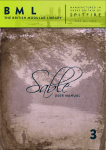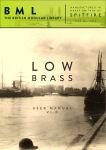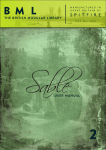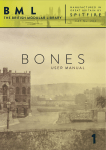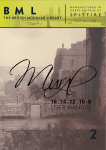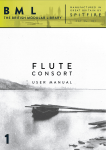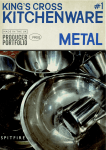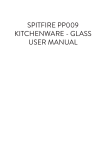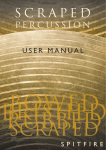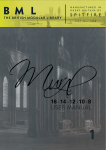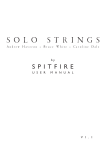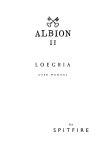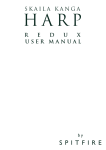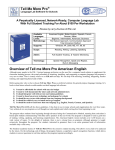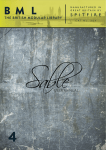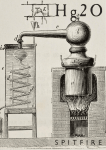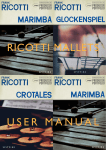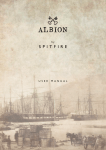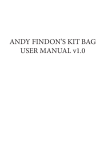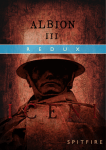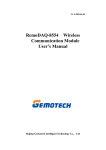Download S E C T I O N - Amazon Web Services
Transcript
B M L T H E BRITIS H M OD UL A R L I B R AR Y MANUFACTURED IN G R E AT B R I TA I N B Y S P I T F I R E C AT H O R N S E C T I O N U S E R M A N U A L V 1 . 0 1 N o . 2 0 1 WELCOME Thanks for purchasing BML Horn Section Volume 1. The first of our definitive deeply sample and detailed brass range. We strongly urge you to read this manual as the BML range is packed with features not found yet in some of our other products. With particular attention to the Front Panel (page 7) which is designed lovingly to help you get the most out of these samples and to make them your own. About Spitfire Audio: Spitfire was formed in 2008 by a group of successful British composers as a means of producing the tools they needed for their busy work schedules. Sick of dry, humourless, ugly, unrealistic enormously untamable sounding libraries, Spitfire set about redefining the way samples were created. Our aim is to reproduce the conditions of top movie recording sessions and approach sampling as if we were recording a film score one note at a time. We don’t imitate how film scores are recorded, we replicate them by using the same facilities, signal chain, techniques and musical & technical talent. We record performances, and parts thereof, not scientifically created samples and importantly we record the room they play in. If you are wanting perfectly tuned, normalised or “dry” samples you have probably come to the wrong place. For here you may find the odd string squeak, a “fruity” note, and lots and lots of “room” but put the whole package together, write some beautiful music and suddenly this library and our approach will make perfect sense. In thanks to using the greatest talent we have available to us in the UK alongside the greatest facilities and technicians, Spitfire Audio supports the British music industry by paying the highest rates possible to it’s contributors alongside a royalty based on the success of sales. So in buying this software you are also supporting British musicians, studios and technicians and we thank you for that. About The British Modular Library: The British Modular Library is to be a deeply sampled, extensive set of tools providing composers with the ability to add fine aspects of extreme detail, musical expression, beauty and focus to their work. To greater understand the instruments your writing for. To encourage you to write music that musicians love to play and to get the most out of smaller ensembles and the wealth of timbral colour and character they can add to any project. Recorded the “SPITFIRE WAY” and showcasing the finest musicians in the UK today playing the rarest and most priceless instruments. The BML will demonstrate why London is the oft preferred scoring location for composers the world over. After many years of development experience Spitfire will present this library with a user interface and set of features unprecedented in any library to date. With 7 mic positions, recorded at 96k through vintage valve and ribbon mics to 2” tape through custom Neve “Monserrat” preamps and Prism convertors at the hall in Air-Studios, one of the greatest scoring stages in the world. With different stereo and 5.1 mixed versions from our chief engineer Jake Jackson the library is designed to be scalable for a variety of systems, from your laptop on the red-eye from NY to LA to your multi slaved rig back at your studio compound! BM L C A T. 2 0 1 THE B R I T ISH MODUL A R LI BRA RY H O R N PA G E 2 S E C T I O N 1 201 HORN SECTION VOL. 1 T H E S TA R T O F S O M E T H I N G T R U LY A M A Z I N G After a decade of enjoying the delights of enormous sample libraries, providing broad brush stroke approaches to writing, which have successfully dominated film, gaming and TV music to a large extent, Spitfire are at last proud to present a new set of tools. Indeed the finest of tools you need to write detailed and focussed orchestral works that have a personality and style that represents your personality, that expresses your creative will and provides you with fresh pastures of experimentation. Recorded both as Solo and a2 (giving you 3 totally different players on different instruments in different positions when played tutti) and played by some of the greatest horn players on the planet today. Composers have been travelling the world over for many years now, our strings are formidable here in London alongside our woodwinds and brass. But the horns? There’s just something about our horns, maybe it’s the colliery tradition, the numerous symphony and chamber orchestras, the three major opera houses, several world class concert halls and 80+ theatre pits and buzzing film business in London alone. It leaves our horn players a cut above the rest of the world, so-much-so we’ve heard of clandesting “replacement” sessions taking place for horns under the cover of darkness for scores being recorded elsewhere. Combined with the majesty of the hall at Air, that signal chain, that 2” tape, Jake Jackson’s mastery of the room and the mixes, we’re sure you’ll agree you’ve just laid your hands on something truly special. Before putting the keys in the ignition just a quick word on musicians. Without them we wouldn’t have this library. Its designed to help us all write better music for them to play. To hire smaller bands and have them play material that is appropriate to their size. To encourage people who have never written for horns to dive in with confidence. We are not here to do away with musicians (we wouldn’t pay them a voluntary royalty from sales if we were!). So whenever you can, please go live, even if its one or two players. A single solo horn on the top line can make all the difference so even if the budget doesn’t permit, ask your producer or director to see what they can find down the back of the sofa. BM L C A T. 2 0 1 THE B R I T ISH MODUL A R LI BRA RY PA G E 3 H O R N S E C T I O N 1 CONTENTS SPECIFICATIONS5 LETS GET STARTED6 THE FRONT PANEL7 THE ARTICULATIONS8 GENERAL & EXPRESSION 10 MICS & MIXES11 ADVANCED12 OSTINATUM13 THE PUNCH COG15 UACC16 BM L C A T. 2 0 1 THE B R I T ISH MODUL A R LI BRA RY A COUPLE OF TROUBLESHOOTS 18 A QUICK THANK YOU 19 PA G E 4 H O R N S E C T I O N 1 SPECIFICATIONS KONTAKT BML is NOT a Kontakt Player library, so you WILL need a full version Kontakt to run it. PLEASE MAKE SURE YOU HAVE THE LATEST VERSION OF EITHER KONTAKT 4.2.4 OR 5 INSTALLED. Because this module doesn’t authorise through the NI Service Centre and is personally watermarked, you will be able to install on all the machines you own. Owning a full version of Kontakt will afford you the luxury of being able to edit and revise the patches to your particular preference. Remember we pride ourselves in making truly esoteric tools, so if there’s a sample you don’t like, you can change it for another with relative ease (check out the new Punch Cog on page 15 to see how you can easily do this). RECOMMENDED SPEC: The better your computer, the better the performance of any Spitfire module. But not to worry if you’re not spec’d up to the hilt. All programs are provided with a set of parameters that enable you to tone back the CPU demands of any given patch. But moving forward, we’re confident this module will keep your computer busy for many years to come! We recommend a combination of high processor speeds, a good chunk of memory and a devoted 7200rpm eSata, USBII, Thunderbolt, or Firewire audio drive. The more memory you have, the less demand placed on your drive, and having a totally devoted drive gives you the chance to load less into memory and reduce load times. The higher the speed of your CPU, the more capable your computer will be to deal with some of the amazing, but complicated scripts we’ve written. PCs: We recommend Windows 7 (latest Service Pack, 32/64 Bit), Intel Core Duo or AMD Athlon 64 X2, 2 GB RAM (4 GB recommended). MACs: We recommend Mac OS X 10.6, 10.7 or 10.8 (latest update), Intel Core 2 Duo, 2 GB RAM (4 GB recommended). DRIVES: Firewire, USBII, or eSata, 7200rpm. Ask your dealer for drives that are suitable for “AV use”. We always recommend as small a drive as possible, as the platter will be smaller and the seek time less. Depending on what mic positions and mixes you download the library will eventually take up 20-120 Gig on your hard drive. If using several large libraries, or a number of Spitfire modules from the same machine, we really recommend having your samples distributed over a number of drives. Lacie eSata or Quadras 7200rpm we highly recommend. Moreover, an exciting development lies in the recent arrival of some amazing solid state (SSD) drives. With seek times reduced to a fraction (0.1ms vs 6-9ms) of what standard drives can offer, we are certain you will be able to reduce your sampler’s “pre-load” (page 15.) buffer tenfold meaning you’ll be able to load enormous orchestral palettes into a single machine. HOST: The Kontakt 4 platform should work comfortably on most commonly found platforms and DAWs. As always make sure you’re as up-to-date as you can afford! If you’re planning on building or adding Spitfire to an already large orchestral palette, we recommend running your library independently of your DAW, either on your host computer (e.g. via Re-Wire) or on a slave device (e.g.. via Midi or MOL). This will assist your loading times, and will allow your DAW to do what it does best, sort out all your note ons and note offs! We heartily endorse Plogue Bidule (www.plogue.com) as a virtual rack/ routing system. For more advice and information about setting up please check our website. BM L C A T. 2 0 1 THE B R I T ISH MODUL A R LI BRA RY PA G E 5 H O R N S E C T I O N 1 LETS GET STARTED Because you’re reading this manual, we can presume you have successfully downloaded your BML product. Included in your download email are some detailed installation instructions, please follow these carefully before going any further. We’ll see you back here, when you’re installed! Before opening Kontakt please make sure you have THE LATEST VERSION OF KONTAKT 4.2.4 OR 5 INSTALLED. 95% of all service enquiries relating to spurious or strange behaviour of our wares are solved by installing the most recent version. As this is NOT a Kontakt Player Library YOU WILL NOT SEE THE MODULE IN THE LIBRARY PANE. Simply navigate to the HORNS via the “File” browser pane. If you have never used Kontakt before we wholeheartedly recommend your familiarise yourself with the basics of patch (or instrument) loading, multi management, outputting and MIDI routing detailed in the Kontakt user-manual provided with your copy of Kontakt or in the “documentation” folder of your Kontakt file. HORNS FOLDER STRUCTURE BML is ingeniously designed for you to have everything you need in relatively few patches, or instances. You basically do most of the sound navigation within these instances. But we have built a selection of preset patches or “Brush Sets” that pre-load useful selections of sounds to cut down on the time you need to build your template, or indeed to make best use of your system resources. SOLO HORN & HORN a2 - ALL IN ONE - Load these to get the full BML experience! ECONOMICAL PATCHES - A collection of less stressful (system-wise) instruments. INDIVIDUAL PATCHES - For the template-heads out there. Each articulation loaded into it’s own solitary instrument with keyswitches/ articulations locked. OTHER PATCHES - Including: THE PUNCH COG - See page 15 this is a cog enabled all in one. TIME MACHINE - Two time machine activated patches for shorts. ALBION OVERLAYS - These are ingeniously designed to load up alongside, even on the same MIDI channel as their Albion cousin so that they can be played and mixed in total unison! (See page 19). BM L C A T. 2 0 1 THE B R I T ISH MODUL A R LI BRA RY PA G E 6 H O R N S E C T I O N 1 THE FRONT PANEL MIC/ MIX POSITIONS GENERAL CONTROLS EXPRESSION CONTROLS DEFAULT CCs ARTICULATIONS BM L C A T. 2 0 1 THE B R I T ISH MODUL A R LI BRA RY PA G E 7 CC1 CC11 CC16 CC21 CC22 CC23 CC24 CC25 CC32 - Dynamics - Expression (0-100% fade) - Speed - Vibrato - Mic 1 slider - Mic 1 slider - Mic 1 slider - Mic 1 slider - Articulation control H O R N S E C T I O N 1 ARTICULATIONS (BRUSH SETS) ARTICULATION STANZA On the right of the diagram above you will see a line of musical notes. These actually denote key articulations, display the current articulation playing and act as switches between them (alongside they’re associated keyswitches). We have created a series of presets with different articulations loaded (SEE PRESETS IN GENERAL CONTROLS PAGE 9). LOAD TOGGLES - The little RAM chips beneath the notes denote load status of the articulations. If you play and articulation that isn’t loaded the front panel will alert you. Click on the chip to load/ unload. i Make sure Kontakt displays the instrument load status as pictured. If the left hand bar is illuminated and red it’s in a queue and hasn’t started loading yet, if the middle bar is lit and yellow the instrument is still loading up. If you try to play before it’s loaded it may not be nice! ARTICULATIONS - Click on these notes to select the different articulations, or indeed press their associated key switches, you can do this whilst your playing so if you want to say switch from a “long” articulation to a short hit the key whilst you’re playing your last long and the next note will be a short. A brief guide to these articulations is displayed overleaf. SIDE BAR DISPLAY AND ADVANCE TOOLS On the left of your articulation stanza is a side bar that displays the name of the articulation you’re currently playing. Beneath it are three options. KEYSWITCH SHIMMIER - This shimmys the position of all the keyswitches left or right, convenient if you’re creating your own “multi” instruments and don’t want to hit keyswitches by mistake. KEYSWITCH TO CC SELECTOR - Use this to assign a CC controller to act as articulation/ keyswitcher. Click on “CC” and you’ll be prompted to move the controller you wish to use in order for the instrument to “learn” how you’d like to select articulations. ARTICULATION LOCKER - We all like to select articulations and use our templates in different ways. Many composers like to have a single articulation loaded to each instance of an instrument for example. So its worth locking off the articulation switching once you’ve selected one so you don’t have sounds disappearing from slaves way off in your machine rooms! Unlocked Artic’ - Is the standard setting, select articulations via the front panel or associated keyswitch. Locked Artic’ - This locks your articulation so it doesn’t change either via front panel or keyswitch. Locked Keyswitch - This locks your articulation via keyswitch but you’re free to switch via the front panel. Locked to UACC - This is a new standard being developed by Spitfire and detailed on page 16. The default controller channel is #32 but this can be changed by right/ CTRL clicking on the padlock. Please also see “advanced articulation selection” on page 12 for more articulation switching options. BM L C A T. 2 0 1 THE B R I T ISH MODUL A R LI BRA RY PA G E 8 H O R N S E C T I O N 1 A BRIEF GUIDE LEGATO - These are true legato patches where every possible interval within the range we have selected has been recorded. They are monophonic and rely on you overlapping the notes otherwise the start of the sample will be re-triggered. We have recorded 2 different legato styles for the Horns a2; “fingered” (simply fingering a new note), and “Tongued” (a slightly detache tongued transition) and just the fingered for the Solo Horn (Tongued is in Vol 2!). These use dynamic controllers (SEE EXPRESSION CONTROLS page 10). LONGS - Marked “Regal”, which is a warm soft tone going up to a strong declaimation without vibrato. These use dynamic controllers (SEE EXPRESSION CONTROLS page 10). LONGS CUIVRE - Cuivre means “brassy” and the players play a full string edgy tone here at full tilt! STOPPED LONGS - The players use the cupped hand to “stop” the bell of the Horn to produce the characteristic nasal sound. These use dynamic controllers (SEE EXPRESSION CONTROLS page 10). MARCATO - This is the longest short note - and it has a round marked attack. TENUTO - This is the medium length short note, with a tenuto feel. STACCATO - The shortest of our shorts. MULTI TONGUE - This articulation gives you two controls: Use the MW to switch between double (0-41) triple (42-84) and quad tonguing (85-127) --- and use velocity to change the final note of the pattern: Velocity 1-80 plays a sample with a tight, abrupt end, and Vel 81-127 plays a sample with an accented, longer end. FLUTTER - The player makes a rasping flutter noise by saying “brrrrr” into the mouthpiece while they play. This is an inherently unstable and therefore fabulously real world sound to use in your score! TRILL MAJOR & MINOR - These long articulations are made by rapidly alternating fingers between the tonic and a semitone (half tone) above. Nice to use as long phrases but also just little frills or ornaments within legato phrases. If you play with a higher velocity the start of the sample is cut into slightly to give you a more ‘immediate’ response. RIPS & FALLS - These are fx of quick glisses up to and down from the note you play on the keyboard. You can control them in two ways: Longer rips/falls are on MW from 0-64, Shorter one from 65-127 --- and there are two dynamics controlled by velocity. BELLS UP LONG, QUAVER and STACCATO - These last three articulations are played with the Bells of the instruments held high, and have a forceful power to them! They are a beautiful long punch and two lengths of short note. BM L C A T. 2 0 1 THE B R I T ISH MODUL A R LI BRA RY PA G E 9 H O R N S E C T I O N 1 GENERAL CONTROLS OPTIONS PRESETS - This allows you to load predetermined sets of articulations affectionately called articulation sets (see page 5) quickly and easily to optimise your system quickly for essential articulations or to start building templates using empty “shells”. PURGE UNUSED - This control keeps unloading any samples you are not using to keep your memory usage as low as possible. TRANSPOSE - Toggle this on and tweak the number to the right to transpose your instrument. Note this is not the same as tuning, the instrument will actually offset the samples to the selected pitch. A great way to “track up” BML and make it sound bigger! CC1 MAPPED VEL(OCITY) - Click this to have velocity controlled dynamics (for the shorts for instance) mapped to CC1 as it is with the longs. FP HALL TRIGGER - This new feature cleverly tracks your dynamic use of the instrument any sudden reductions in dynamic don’t “suck” the hall out with it. Great for forte-piano moments, but only use if you’re sure you’re going to need it as it uses more voices than in standard operation. ROUND ROBINS & LEGATO ROUND ROBINS - This refers to the number of round robins (multiple recordings of the same notes that cycle around as you repeatedly play a note) your instrument uses, the number can be dragged up and down (1-8) to save you memory. RESET FROM F0 - This enables you to control the round robin cycle (so it sounds identical every time you play) toggle on & play the key selected (default F0) to reset. RESET ON TRANSPORT - As above but resets every time you press play! Genius! NO EXTRA FUNCTIONALITY (NEIGHBOURING ZONES)- Next to this lies a pop-down menu with some amazing new functions: • “No extra Functionality” - Is the standard default where round robins are used as they were intended. • “Neighbouring Zones” - pulls from neighbouring zones, so for an ‘8RR’ instrument, you effectively cycle through up to 24 different sounding notes when pressing a key. It’s still just playing the one RR at a time, though giving you more of them. In legato mode this also alternates between 3 legato intervals to give a fake round robin. • “2x Round Robin With Skip” - plays two RR simultaneously, so you get a thicker sound, it’s the equivalent of plopping two notes on top of each other in your DAW (and it drops the overall volume ~6db so that the levels remain the same but it just sounds thicker). NB THIS IS NOT AVAILABLE TO LEGATO TRANSITIONS. This plays the pairs and moves ahead by 2 RR. In this mode RR is effectively halved. eg, if you press a note it would play RR1/RR2 then RR3/RR4 ,etc. • “Layer 2x Round Robins With No Skip” - As above but this plays a pair but doesn’t move ahead by 2 so that RR isn’t halved. So if you press a note it would play RR1/RR2, then RR2/RR3, then RR3/RR4. EXPRESSION CONTROLS Visual representation of the various expression controllers available to you right/ ctrl click to reassign/ learn different controller assignments. DYNAMICS - (DEFAULT CC1 MOD WHEEL) Control and xFade the different dynamic layers recorded. VIBRATO - (DEFAULT CC 21) Controls and xFades level of vibrato. SPEED - (DEFAULT CC 16) Controls the speed of legato transitions, reduce when playing in, expand when playing back for ease of use. EXPRESSION - (DEFAULT CC11) Controls the volume of the articulation. BM L C A T. 2 0 1 THE B R I T ISH MODUL A R LI BRA RY PA G E 1 0 H O R N S E C T I O N 1 MICROPHONE/ MIX SETTINGS Welcome to the wonderful world of Air Studios and the mixes of our chief engineer Jake Jackson. Use the chips beneath the faders to load unload different microphones and the faders above to tweak the balance of them. Turning a fader all the way down will also unload the mics, conversely turning the fader back up will reload. Right/ CTRL click on the faders to assign CC controllers so you can mix these live for fantastic shifts in the spacial nature of the samples. MICROPHONES / MIXES Right/ Ctrl click on the mic letters to change Kontakt channel/output assignment. STANDARD ARRAY: C - Close mics, a selection of valve mics placed for optimum focus close to the instruments. This mic control is great to add in for added definition and at times a bit of “rounding of sound”, in isolation it can be a way of achieving a more intimate or pop-music style sound. T - Tree. This refers to the “Decca” tree of three mics placed above the conductors podium. In the case of Sable; 3 priceless vintage Neumann M50s. These are placed to give the ultimate sound of the band, the hall and are the default mic position that loads in with each patch. A - Ambient. A set of condenser mics placed high up in the gallery away from the band. This mic position gives a massive amount of stereo spread and room sound over the band. Great mixed in with the other mics but also ideal fed to your Ls & Rs speaker sends for true surround information. O - Outriggers, a set of vintage mics placed wide apart to the left and right of the tree. These give a similar balance of room and band but with a broader stereo spread. The effect of this mic is somewhere between the tree and ambient mics. EXTENDED ARRAY: ST - Stereo Mic. These are totally different mics in a totally different position to the tree (closer to ground level) and have a more direct and immediate sound than the tree. G - Gallery mics, three mics at the very furthest point from the band way up in the gallery. A true representation of Air-Studios’ amazing ambience. CR - Close ribbons. Placed next to the standard close mics but using a rarefied selection of vintage ribbon mics to add a warm and rounded tone. JAKE JACKSON MIXES : 3 extraordinary mixes to save your system resources B - Broad, a cinematic/ symphonic mix that allow the hall to really speak out. M - Medium, a more intimate but still very classic version of the mix above. F - Fine, a much more detailed and immediate sound with less hall, great for pop! BM L C A T. 2 0 1 THE B R I T ISH MODUL A R LI BRA RY PA G E 1 1 H O R N S E C T I O N 1 ADVANCED STUFF. MICROPHONE MIX TO ARTICULATION LINKER The small notation symbol locks the microphone mix or tweak you’ve made to the articulation selected. This means if you want to boost any perceived inconsistencies in volume between say pizzicato and col legno you can. Or indeed if you want to roll off some of the hall ambience for a short versus the long articulations this is how to fine tune. CLOSE MIC PAN COLLAPSER To the right of the above is a selector that opens the mic collapser: The close mics are a stereo mix and this collapser allows you to refine how the stereo image is handled. All our musicians are recorded in-situ, ie where they would be seated on a standard scoring session, giving you a fantastic spectral spread when putting all the elements together, which helps define the detail. This panning tool helps you to manage and tweak this to your own tastes/ needs. STEREO WIDTH - Allows you to control how far the stereo image reaches. All the way to the right would be like having your two pan pots panned hard. All the way to the left would be like having both pots centre, STEREO PAN - Then allows you to control where in the pan field the centre of this image is placed. ADVANCED ARTICULATION SELECTION. For those of you who want to tweak your articulation selection further. To create set-ups that closely integrate with notation software or indeed performance patches that react to the way you play this deep editor may be for you. It’s accessed by holding CMD (or CTRL on PC) and clicking the articulation icon? Can be closed by clicking the X to the bottom right of the UI. LATCH TOGGLE - Switches this way of selecting the articulation on. “WITH” SELECTOR - Selects how you would like to select. PARAMETERS - Edit these to select a range in which this articulation would be selected. Please also see our chapter on UACC (page 16) for further options on articulation selection. BM L C A T. 2 0 1 THE B R I T ISH MODUL A R LI BRA RY PA G E 1 2 H O R N S E C T I O N 1 THE OSTINATUM (Acces via the icon beneath the spanner) SETTINGS RHYTHM COMPUTER TRANSPORT BM L C A T. 2 0 1 THE B R I T ISH MODUL A R LI BRA RY PA G E 1 3 H O R N S E C T I O N 1 OSTINATUM FRONT PANEL - “Why let ALBION have all the fun?!” We’ve ported this over from the Albion range (see page 19). Best used with short articulations this ever evolving device that can offer instant chaotic inspiration, be used to create scientifically designed rhythms, ostinati and arpeggiated sequences, to shimmering tremolando effects. SETTINGS: LOAD/ SAVE - Allows you to store your preciously made Ostinati. MODE - Selects how the Ostinatum will interpret your playing. Ostinatum will sequence a maximum of 10 notes (one for each of your fingers). It needs to arrange them into a note order “1-10” and this determines how it does that. OFF - The default postion Ostinatum remains dormant. ORDER PRESSED - This will organise the notes in the order you pressed them. ASCENDING - From bottom to top. DESCENDING - From top to bottom. CONTROL KEYSWITCHES - Allows you to set up a section of the keyboard that controls the state of the ostinatum. These keyswitch let you turn it off, or set the Mode. SOLO KEYSWITCHES - Allows you to dedicate a section of the keyboard to keyswitches that solo each ostinatum track. The first KS turns all tracks on, the following KS solo each individual track. CHORD MODE - This ignores any note order and simply plays everything polyphonically, great for measured trem style effects. TRANSPORT: This is a real time “note order” display. So with “Ascending” mode activated a c major triad played from middle C up will show up 1=C4, 2 = E4, 3 =G4. These note numbered assignments are processed in the.... THE RHYTHM COMPUTER NOTE MENU - Click these to place a note into the computer at the length you desire. Trash removes and scroll down different pre-designed sequences to the right of this. The cog allows you further fine tuning and configuration tools. LENGTH - This displays the note lengths in sequence that you have selected from the Note Menu. Drag down here to create rest versions of the note length. KEY - Under each note you can then select which key (displayed in real time in the Transport) this note is attached to. Scroll up and down to select. So in the sequence pictured a C triad will sound C,E,C,C,C,C. OFFSET - Adjust these bars up and down to adjust the velocity levels of each notes, this will bring your rhythm sequence to life and provide you with all sorts of surprising syncopated accents. NOW HIT PLAY ON YOUR DAW AND ENJOY! BM L C A T. 2 0 1 THE B R I T ISH MODUL A R LI BRA RY PA G E 1 4 H O R N S E C T I O N 1 THE PUNCH COG (Available on Instruments saved in the “Punch Cog” folder) As we record our samples like you would a film score, we actively encourage our musicians to make every note sound different. To play with the flair that would be expected from them on a score shoot. We like tuning imperfections, little squeeks, the odd breath of a human! We like our pizzicatos loose and for the odd “rub” between players when playing transitions. However much we apply our exacting taste principals onto our range we’re never going to meet with everyone’s preferred quality bar, or needs and expectations of a project. So we present to you Blake Robinson’s coup de grace.... A way of punching notes in and out like we used to in the old days. A way of customising your library to fit your taste and needs. If there is a round robin you don’t like or a long note where the tuning is a bit fruity. Load in a “Punch Cog” instrument, and switch to the articulation you were using. Play until you find the Round Robin you don’t like and then stop. Observe the pictured cog bottom left of the front panel/ UI, and click on it to get this dialogue: HOW SHOULD WE TWEAK - Then your last note played will be displayed, if this is correct get tweaking. SKIP THIS RR - Will simply make it always jump along to the next round robin in the cycle. ADJUST TUNE/ VOL - Will adjust the tuning and or volume of the last played note. ADJUST RELEASE - This will alter the level of the release trigger (which will effect the percieved decay of that note). SAMPLE START - If it feels loose adjust to the right, tight adjust to the left. REMOVE ALL NOTE TWEAKS - This removes all custom changes you have made with the Cog. BM L C A T. 2 0 1 THE B R I T ISH MODUL A R LI BRA RY PA G E 1 5 H O R N S E C T I O N 1 UACC UNIVERSAL ARTICULATION CONTROLLER CHANNEL We finally admit that things have got out of hand here in the world of Virtual instruments. Every single one works differently, responds differently to different key switches and controllers, and thats just within our own library! The UACC (pron’ you-ack) project is our attempt to unify articulation switching across our entire range and it’s one we hope other developers will also adopt. It will mean greater integration between your VI set templates, greater encouragement to venture into the darker, less visited corners of your collection and a smoother workflow. When selecting “Articulation Locked To UACC” you disable what we believe to be the soon-outdated keyswitch method of articulation selection. In favour of UACC which defaults to channel #32 (change this by right-clicking the CC slider next to the padlock). This then gives you the option of using a MIDI controller to select articulations based on the list below. We recommend a switch based controller or an iPad app. Alternatively simply dial in event or automation data on your DAW. The latter will give you the ability of always being on the correct articulation, even if you haven’t rolled your sequence back before the midi event. This list is a work-in-progress and we look to users and other developers to finalise it. 1 2 3 4 5 6 7 8 9 10 11 12 14 15 16 17 Longs (vib xFade CC21) Longs con sord Longs alternate mute Longs sul pont Longs con sord sul pont Longs sul tasto Longs flautando Longs (artificial) harmonics Longs SUL lowest string Longs sul pont heavy distorted Longs Cuivre (brass only) Longs vib13 Longs flutter Longs hollow (flutes only) Longs overblow (flutes only) Longs overblow flutter (flutes only) Longs Mariachi (if separated off) 21 22 23 24 25 26 27 28 29 Legato Legato con sord Legato SUL lowest string Legato half section Legato half section con sord Legato sul pont Legato fast run (if separate patch) Legato flautando Legato harmonics - CONTINUED: BM L C A T. 2 0 1 THE B R I T ISH MODUL A R LI BRA RY PA G E 1 6 H O R N S E C T I O N 1 - CONTINUED: 41 42 43 44 45 46 47 48 49 50 51 52 53 54 55 56 57 58 Spiccato (strings only) Shorts spiccato Staccato Staccato dig Spiccato con sord Feathered spiccato Staccatissimo Tenuto shorts Marcato shorts Combined shorts via velocity, with dyn on MW Staccatissimo con sord Tenuto shorts con sord Marcato shorts con sord Combined shorts via velocity, with dyn on MW con sord Staccatissimo con sord ALT Tenuto shorts con sord ALT Marcato shorts con sord ALT Combined shorts via velocity, with dyn on MW con sord ALT 61 62 63 Pizzicato Pizz Bartok Col legno battuto 71 72 73 74 75 Trills min 2nd Trills maj 2nd Trills min 3rd Trills maj 3rd Trills perf 4th 81 82 83 84 85 86 87 88 89 90 91 92 93 94 95 96 Trems - unmeasured Trems - unmeasured con sord Trems - unmeasured sul pont Trems - unmeasured con sord sul pont Trems - measured 180 bpm Trems - measured 150 bpm Trems - measured 120 bpm Trems - measured TM 180 bpm (time machine) Trems - measured TM 150 bpm (time machine) Trems - measured TM 120 bpm (time machine) Double tonguing Triple tonguing Quad tonguing Double tonguing con sord Triple tonguing con sord Quad tonguing con sord BM L C A T. 2 0 1 THE B R I T ISH MODUL A R LI BRA RY 111 112 113 114 115 116 117 118 119 120 121 122 123 124 125 FX 1 FX 2 FX 3 FX 4 FX 5 FX 6 FX 7 FX 8 FX 9 FX 10 Disco falls Rips Falls Rips con sord Falls con sord H O R N PA G E 1 7 S E C T I O N 1 A COUPLE OF TROUBLESHOTS This is a manual to accompany v1.0 of a totally new line for Spitfire. With a totally new set of samples, scripts, and UI. We have used our experience as busy film composers to deliver something that we’d like. It is our hope that you keep in touch with us to let us know how you’re getting on, how you’re using SABLE, how you’re finding it, and, if we were to consider looking at areas in the future, what you’d like us to look at. From this we’ll form a consensus and wholeheartedly pledge that we will act upon it wherever possible or practical. We’ve already recorded new material which will be distributed for free in service updates. We do this because, even after years of experience, it’s not always easy to predict how things turn out. So we leave space in our budgets to go back and record stuff that may not have worked as well as we like, may need expanding upon, or to widen the scope of something that’s surprised us and we want to make more of. Keep an eye on your in-box and our site for new additions to the Sable range and others and of course our site. A couple of commonly asked questions... • This library really isn’t behaving how I’d expect. - OK, so we’re now officially blue in the face. But before you go ANY further please check you are using the ABSOLUTE latest version of Kontakt. Visit your trusty service centre and we hope this page remains relatively under-thumbed. • My instrument or patch seems to be playing just bits of sound, some keys are missing, and there’s lots of clicks and crackles. - Make sure that your patch is fully loaded (detailed on the front panel, page 8). Some of these are biggies so can take a while. But if problems persist make sure Kontakt memory manager is activated: then: You’ll have to restart this instance of Kontakt to feel it’s benefits. Another reason your system may be struggling is that you’re using too many mics live for the spec of your machine. Try cutting the mics as detailed on the front panel to see if this cures your problem. If it does, don’t worry you can still use these mics, just play in your parts with one active (we recommend the T(ree)) and then activate multiple mics and render down (eg. freeze function in Logic Studio). Some DAWS (ahem, Logic) only use one core of your computer when recording but will use more when playing back so again try recording with just one mic then dial in others once you’re happy. If you’re still suffering may we suggest you try and manage your pre-load buffer. Kontakt pre-loads some samples into memory so that when you hit a note Kontakt plays it out from RAM whilst addressing the rest of your samples from your hard drive(s). The slower your drives, the more you may want to rely on RAM, the faster the drives, or smaller RAM available, the more you may want to rely or your drives. If you’re using the latest generation of SSDs you’ll find you can radically reduce your pre-load buffer. Referring to the plate above tick the “Instruments Default Pre-Load Buffer Size” and drag the fader to a setting you’re happy with. BM L C A T. 2 0 1 THE B R I T ISH MODUL A R LI BRA RY PA G E 1 8 H O R N S E C T I O N 1 A QUICK THANKS Christian & Paul would like to thank Dominic Kelly, Alison Burton and the whole of the Air Studios team. To Jake Jackson for making everything sound so marvellous, and the remarkable talents, immense intellect and invention of James Bellamy, Stanley Gabriel, Andrew Blaney, Blake Robinson and Stu Kennedy. Also to our newest members of out team, Joe & Toby, we’ve got you now we’re never going to let you go! Most of all we would like to thank the amazing support and loyalty of our user-base, our Facebook friends and everyone at VI Control. We are in the same boat as all of you. We’re not content and software developers by trade, so appreciate your honesty in paying your way to be a part of our family and not distributing this illegally. But more importantly, if you have any ideas or criticism please let us know directly via our website in a constructive manner. You never know, you just may have thought of something that we hadn’t considered. We want to make our entire range the best there is, and we rely on you to help us achieve that..... With thanks. Christian & Paul. COPYRIGHT SPITFIRE AUDIO LLP 2013 www.spitfireaudio.com BM L C A T. 2 0 1 THE B R I T ISH MODUL A R LI BRA RY PA G E 2 0 H O R N S E C T I O N 1



















